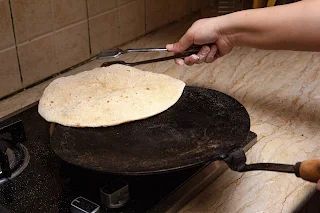Roti, chapati, phulka, or bread makes an important part of our meals. You will be astonished to know that we are working and improving upon a legacy more than 10000 years old.
The earliest of the details of domestication of wheat was seen in the “fertile crescent”.This is the cradle of some of the earliest human civilizations of the middle east. This helped the formation of towns and put a brake on the nomadic lifestyle. Similar developments were seen in the Americas with maize and in Asia with rice.
Archeological Proof
In archeological sites in Jordan (Black Desert) charred crumbs of flatbread were found. 😲 They were dated back to 14600 to 11600 years ago. Bread is also found in Neolithic sites in Turkey and Europe from around 9,100 years ago. These were found to be made from wild wheat, barley, and plant toots. These are said to be the earliest bread cooked by our ancestors from cultivated wheat. um... very smart of them.
We now know that to make flour from wheat, grinding needs to be done. The grinding stones dated 30k years old have been unearthed in different parts of Australia and Europe. I believe that these must be used to make flour for making bread by grinding the available cereals. The gap between the grinding stone age and the age of the cooked bread is huge, almost 20000 years. How was it used during all these years?
In ancient Egypt, evidence of bread making has been found in the form of artistic depiction, items used in bread making, and even remains of the dough and bread itself.
Bread - Significance in Religion & Culture
The bread is the simplest and the oldest of the prepared foods. It is made with only two basic ingredients. flour and water. It is one of the oldest food made by humans and is a by-product of agriculture. It plays a significant role in religion and culture.
In Indian culture, bread is referred to the basic necessities of life when we say- roti, kapda aur makaan. In many cultures, bread is used as a metaphor just as we use it in India as the basic necessities and living conditions. For example - the “breadwinner” is the one who is the household's main financial contributor and in reality, has nothing to do with actually making bread.
The term “breadbasket” actually refers to the agriculturally wheat-productive regions. For example, in India, Panjab and Haryana are said to be the breadbasket of India.
Do you know what are rice bowls of India are?
Our humble roti or flatbread is one of the oldest foods preparation made using fire. It still is present in the earliest forms and has seen growth in its different forms. Isn't it remarkable?
Egyptians are said to be the ones who had discovered that bread made with fermented dough is lighter, porous, and fluffy. They also developed ovens.
The earliest form of bread is our chapati or phulka, which is still used in many parts of the world. We are mainly using wheat in India, other grains used in making flatbreads are maize, corn, millet, buckwheat, etc. These are not so suitable for raised or baked bread as these cereals lack properties.
We make our chapatis or flatbread on a girdle which we call tawa. In rural India, coarse grain like jawar, bajara. jau and Makki are also used to make chapatis along with wheat flour. These days many nutritionists are focussing on the nutritional values of these grains due to their health advantages and these forgotten grains are now repackaged in new marketing jargon are being sold at a premium.
Thin round tortillas which are popular breeds of Latin America are made of maize.
Fermentation is needed to make raised bread. Fermentation is a chemical process in which sugar is broken down and Carbon-dioxide is released. In earlier times, fermentation was carried out by naturally present bacteria or wild yeasts. Now we produce fermentation by using active yeast.
As travel and trade between countries increased, so did the varieties of bread. People learned about the different kinds of bread made in other areas of the world and adapted recipes to incorporate ingredients available in their area.


Comments
Post a Comment